October sell-off: Drawing to a close?
By Colin Twiggs
October 18th, 2014 11:00 a.m. AEDT (8:00 p.m. EDT)
Advice herein is provided for the general information of readers and does not have regard to any particular person's investment objectives, financial situation or needs. Accordingly, no reader should act on the basis of any information contained herein without first having consulted a suitably qualified financial advisor.
Weekly highlights:
- DAX and FTSE find support, but remain in a down-trend
- China is bullish, but Japan bearish
- US stocks find support and continue to indicate a bull market
- ASX respects primary support
The S&P 500 found support at 1820 and is testing resistance at 1900. Breach of resistance would suggest that the correction is over. 21-Day Twiggs Money Flow below zero, however, continues to warn of medium-term selling pressure. Respect of resistance is more likely, indicating another test of support at 1800*.
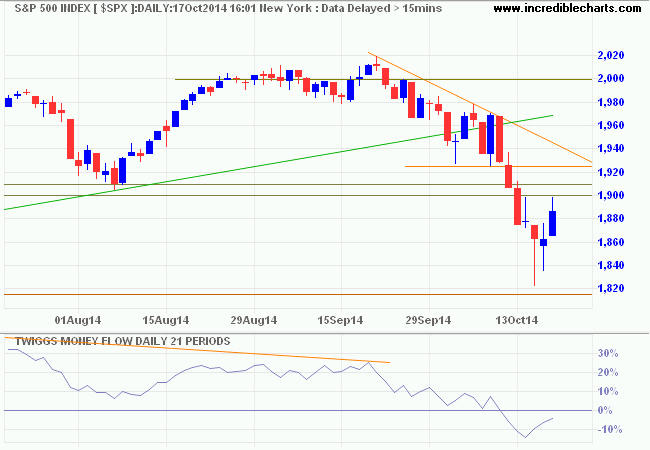
* Target calculation: 1900 - ( 2000 - 1900 ) = 1800
CBOE Volatility Index (VIX) retreated to 22, indicating moderate risk, but nowhere near the 30+ levels typical of a bear market.
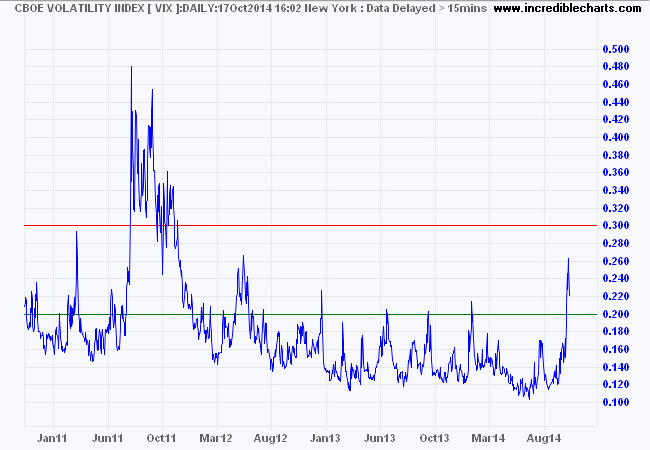
Dow Jones Industrial Average recovered above resistance (the former support level) at 16300, the long tail indicating short-term buying pressure. Follow-through above the descending trendline would signal that the correction is over. Recovery above the recent highs at 25% on 13-week Twiggs Money Flow would suggest that buyers have regained control.
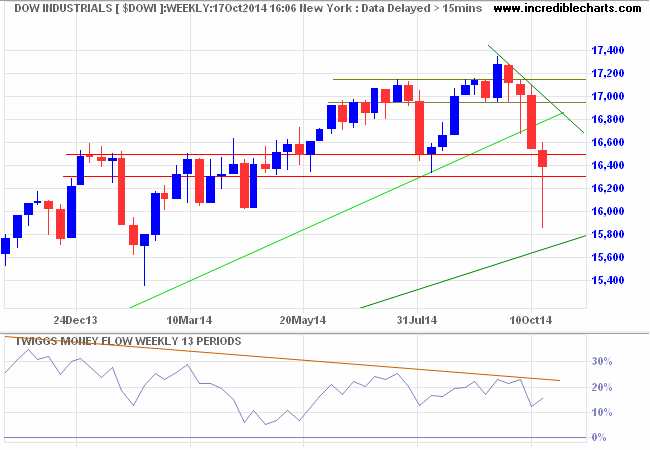
Germany's DAX is retracing to test resistance at 9000. Respect would confirm a primary down-trend. 13-Week Twiggs Momentum below zero strengthens the bear signal. Target for the decline is 8000*. Recovery above 9000 remains unlikely, but would warn of a bear trap.
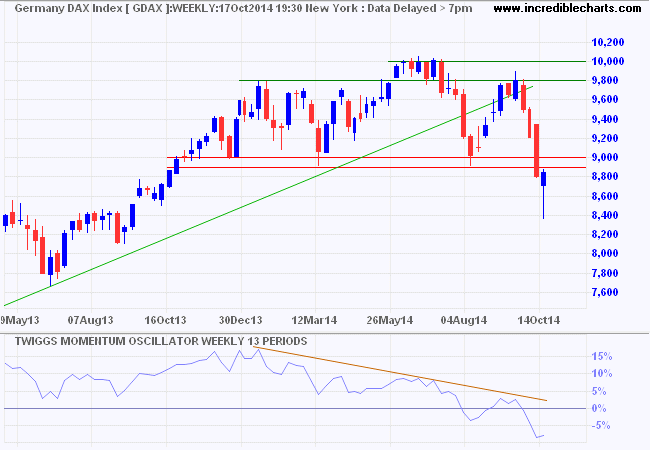
* Target calculation: 9000 - ( 10000 - 9000 ) = 8000
The Footsie displays a similar long tail, indicating buying pressure. Recovery above 6500 is unlikely, but would warn of a bear trap. Respect of resistance would offer a target of 6000*.
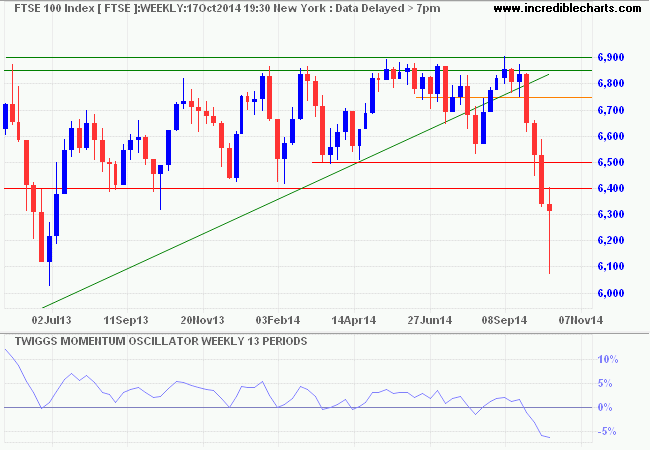
* Target calculation: 6400 - ( 6800 - 6400 ) = 6000
China's Shanghai Composite Index is testing support at 2340/2350. Breach would warn of a correction. But the primary up-trend remains and rising 13-week Twiggs Money Flow signals medium-term buying pressure.
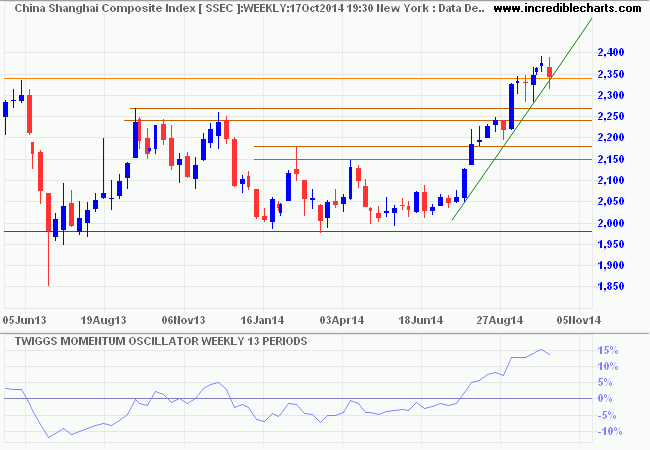
Japan's Nikkei 225 Index plunged through support at 14800, warning of a test of primary support at 13900/14000. Reversal of 13-week Twiggs Money Flow below zero indicates (long-term) selling pressure.
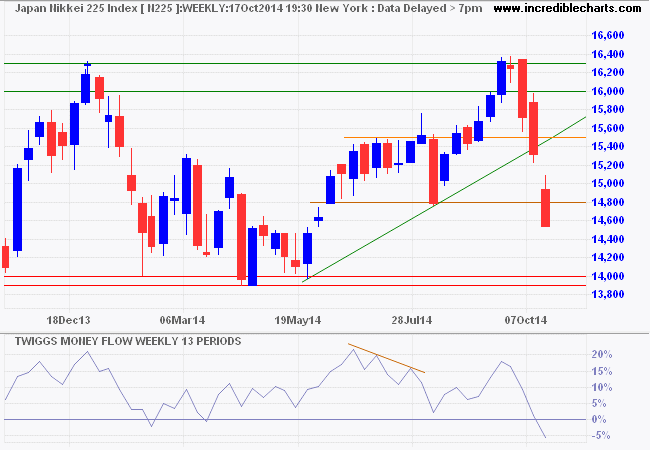
The ASX 200 recovered above resistance at 5250 and the descending trendline, suggesting that the correction is over. Bullish divergence and a rising 21-day Twiggs Money Flow (above zero) indicates medium-term buying pressure. Recovery above 5350 would confirm that buyers are back in control, while reversal below 5250 would indicate another test of 5000/5050.
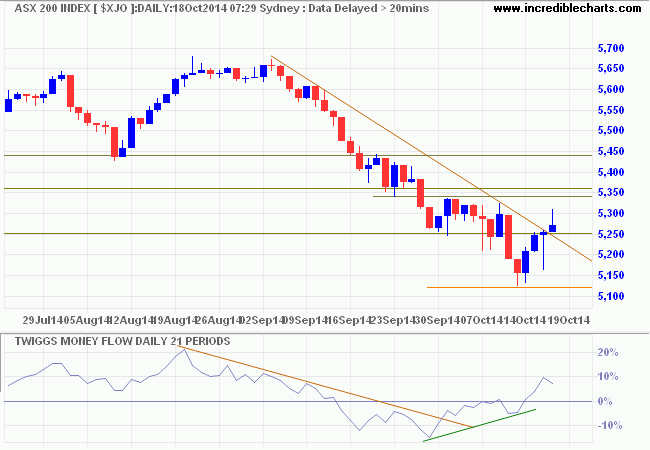
* Target calculation: 5350 - ( 5650 - 5350 ) = 5050
ASX 200 VIX remains below 20, indicating low risk typical of a bull market.
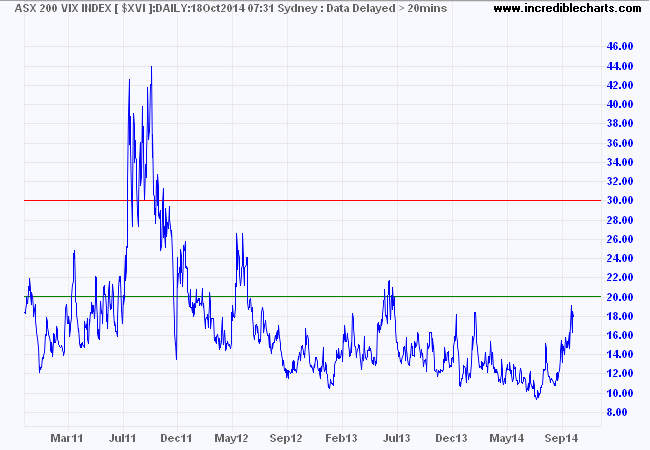
Eliminating emotional bias
Selling pressure from the September quarter-end is now abating. Although we may see further tests of support, this is likely to be followed by a surge in buying from long-term investors. At which point you can congratulate yourself for sticking to your position and not succumbing to temptation to cut losses and run.
The daily media cycle fuels indecision. There are always interests best served by opposing views of the market. Those not in the market would love to see it fall. And those in the market, or who derive an income from market activity, want it to rise. Most will seize on any evidence that supports their view and promote it for all they are worth. Any attempt at objectivity is lost. Treat with suspicion any source that does not present both sides of an argument before delivering a conclusion.
We try to counter any inherent bias using two measures. The first is to employ a disparate set of macroeconomic and volatility filters to identify elevated market risk. Using set rules enforces discipline and reduces emotional bias. But that on its own is insufficient. The second step is to continually examine evidence that conflicts with your conclusion in order to assess whether your model of the economy warrants revision.
Our market indicators continue to indicate low risk, despite the current correction, and we maintain our bullish view on stocks.
Robert Shiller's CAPE
I have long held the view that using Robert Shiller's CAPE to determine whether stocks are under- or over-priced is misleading. Average levels for CAPE have shifted over time, and one cannot rely solely on historic highs and lows as a measure of whether the market is over-bought or over-sold.
So I was interested to learn that Robert Shiller currently maintains 50% of his investment portfolio in stocks. From an interview with Jason Zweig at WSJ:
Today's level "might be high relative to history," Prof. Shiller says, "but how do we know that history hasn't changed?" So, he says, CAPE "has more probability of predicting actual declines or dramatic increases" when the measure is at an "extreme high or extreme low." ....Today's level, Prof. Shiller argues, isn't extreme enough to justify a strong conclusion. So, he says, he and his wife still have about 50% of their portfolio in stocks.
That's all from me for today. Take care.
It was never my thinking that made big money for me. It was my sitting....Men who can both be right and sit tight are uncommon. I found it one of the hardest things to learn.
~ Jesse Livermore
Disclaimer
Research & Investment Pty Ltd is a Corporate Authorized Representative (AR Number 384 397) of Andika Pty Ltd which holds an Australian Financial Services Licence (AFSL 297069).
The information on this web site and in the newsletters is general in nature and does not consider your personal circumstances. Please contact your professional financial adviser for advice tailored to your needs.
Research & Investment Pty Ltd ("R&I") has made every effort to ensure the reliability of the views and recommendations expressed in the reports published on its websites and newsletters. Our research is based upon information known to us or which was obtained from sources which we believe to be reliable and accurate.
No guarantee as to the capital value of investments, nor future returns are made by R&I. Neither R&I nor its employees make any representation, warranty or guarantee that the information provided is complete, accurate, current or reliable.
You are under no obligation to use these services and should always compare financial services/products to find one which best meets your personal objectives, financial situation or needs.
To the extent permitted by law, R&I and its employees, agents and authorised representatives exclude all liability for any loss or damage (including indirect, special or consequential loss or damage) arising from the use of, or reliance on, any information. If the law prohibits the exclusion of such liability, such liability shall be limited, to the extent permitted by law, to the resupply of the said information or the cost of the said resupply.
Important Warning About Simulated Results
Research & Investment (R&I) specialise in developing, testing and researching investment strategies and systems. Within the R&I web site and newsletters, you will find information about investment strategies and their performance. It is important that you understand that results from R&I research are simulated and not actual results.
No representation is made that any investor will or is likely to achieve profits or losses similar to those shown.
Simulated performance results are generally prepared with the benefit of hindsight and do not involve financial risk. No modeling can completely account for the impact of financial risk in actual investment. Account size, brokerage and slippage may also diverge from simulated results. Numerous other factors related to the markets in general or to the implementation of any specific investment system cannot be fully accounted for in the preparation of simulated performance results and may adversely affect actual investment results.
To the extent permitted by law, R&I and its employees, agents and authorised representatives exclude all liability for any loss or damage (including indirect, special or consequential loss or damage) arising from the use of, or reliance on, any information offered by R&I whether or not caused by any negligent act or omission.

Author: Colin Twiggs is a former investment banker with almost 40 years of experience in financial markets. He co-founded Incredible Charts and writes the popular Trading Diary and Patient Investor newsletters.
Using a top-down approach, Colin identifies key macro trends in the global economy before evaluating selected opportunities using a combination of fundamental and technical analysis.
Focusing on interest rates and financial market liquidity as primary drivers of the economic cycle, he warned of the 2008/2009 and 2020 bear markets well ahead of actual events.
He founded PVT Capital (AFSL No. 546090) in May 2023, which offers investment strategy and advice to wholesale clients.
